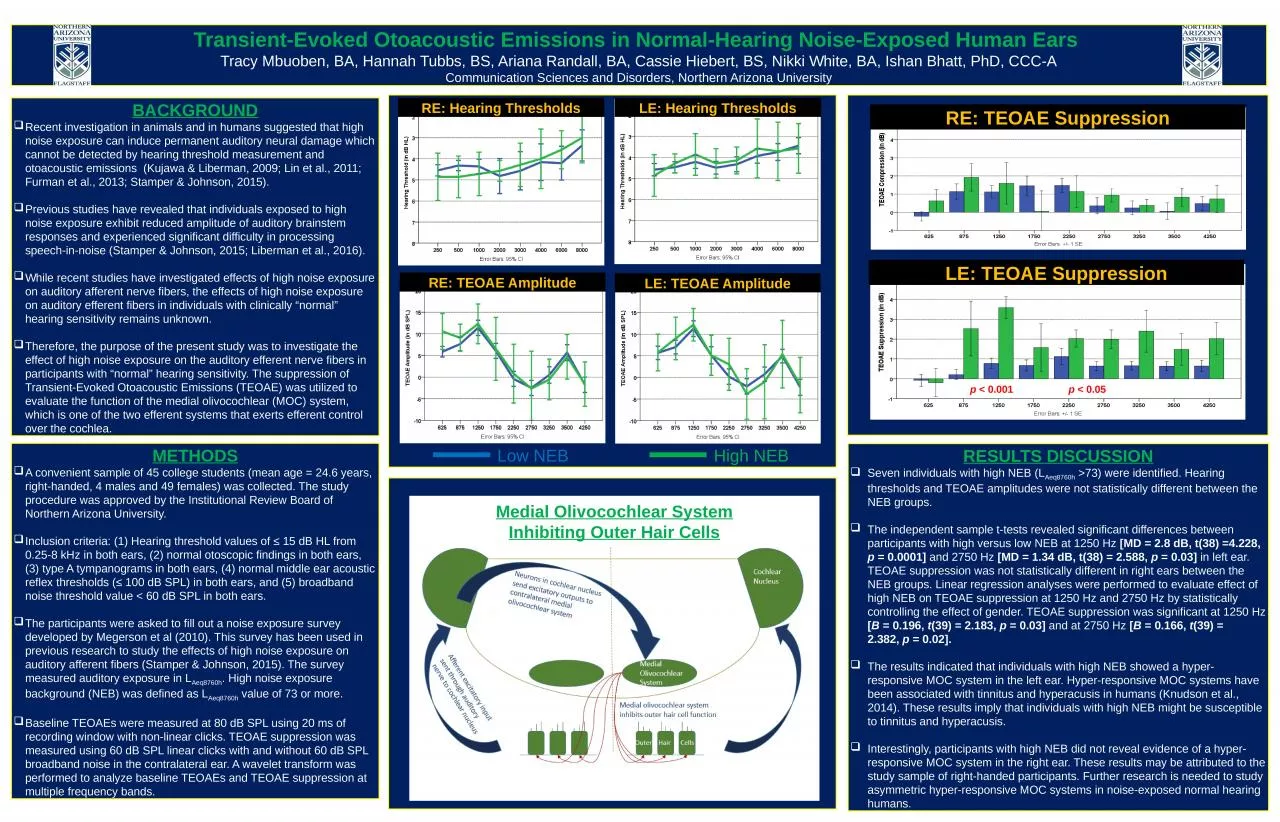

Inclusion criteria 1 Hearing threshold values of 15 dB HL from 0258 kHz in both ears 2 normal otoscopic findings in both ears 3 type A tympanograms in both ears 4 normal middle ear acoustic reflex thresholds 100 dB SPL in both ears and 5 broadband noise threshold value ID: 932343
Download Presentation The PPT/PDF document "METHODS A convenient sample of 45 colleg..." is the property of its rightful owner. Permission is granted to download and print the materials on this web site for personal, non-commercial use only, and to display it on your personal computer provided you do not modify the materials and that you retain all copyright notices contained in the materials. By downloading content from our website, you accept the terms of this agreement.
Slide1
METHODS
A convenient sample of 45 college students (mean age = 24.6 years, right-handed, 4 males and 49 females) was collected. The study procedure was approved by the Institutional Review Board of Northern Arizona University.
Inclusion criteria: (1) Hearing threshold values of ≤ 15 dB HL from 0.25-8 kHz in both ears, (2) normal otoscopic findings in both ears, (3) type A tympanograms in both ears, (4) normal middle ear acoustic reflex thresholds (≤ 100 dB SPL) in both ears, and (5) broadband noise threshold value < 60 dB SPL in both ears. The participants were asked to fill out a noise exposure survey developed by Megerson et al (2010). This survey has been used in previous research to study the effects of high noise exposure on auditory afferent fibers (Stamper & Johnson, 2015). The survey measured auditory exposure in LAeq8760h. High noise exposure background (NEB) was defined as LAeq8760h value of 73 or more.Baseline TEOAEs were measured at 80 dB SPL using 20 ms of recording window with non-linear clicks. TEOAE suppression was measured using 60 dB SPL linear clicks with and without 60 dB SPL broadband noise in the contralateral ear. A wavelet transform was performed to analyze baseline TEOAEs and TEOAE suppression at multiple frequency bands.
Transient-Evoked Otoacoustic Emissions in Normal-Hearing Noise-Exposed Human Ears Tracy Mbuoben, BA, Hannah Tubbs, BS, Ariana Randall, BA, Cassie Hiebert, BS, Nikki White, BA, Ishan Bhatt, PhD, CCC-ACommunication Sciences and Disorders, Northern Arizona University
BACKGROUNDRecent investigation in animals and in humans suggested that high noise exposure can induce permanent auditory neural damage which cannot be detected by hearing threshold measurement and otoacoustic emissions (Kujawa & Liberman, 2009; Lin et al., 2011; Furman et al., 2013; Stamper & Johnson, 2015). Previous studies have revealed that individuals exposed to high noise exposure exhibit reduced amplitude of auditory brainstem responses and experienced significant difficulty in processing speech-in-noise (Stamper & Johnson, 2015; Liberman et al., 2016).While recent studies have investigated effects of high noise exposure on auditory afferent nerve fibers, the effects of high noise exposure on auditory efferent fibers in individuals with clinically “normal” hearing sensitivity remains unknown. Therefore, the purpose of the present study was to investigate the effect of high noise exposure on the auditory efferent nerve fibers in participants with “normal” hearing sensitivity. The suppression of Transient-Evoked Otoacoustic Emissions (TEOAE) was utilized to evaluate the function of the medial olivocochlear (MOC) system, which is one of the two efferent systems that exerts efferent control over the cochlea.
RESULTS DISCUSSION
Seven individuals with high NEB (L
Aeq8760h >73) were identified. Hearing thresholds and TEOAE amplitudes were not statistically different between the NEB groups.The independent sample t-tests revealed significant differences between participants with high versus low NEB at 1250 Hz [MD = 2.8 dB, t(38) =4.228, p = 0.0001] and 2750 Hz [MD = 1.34 dB, t(38) = 2.588, p = 0.03] in left ear. TEOAE suppression was not statistically different in right ears between the NEB groups. Linear regression analyses were performed to evaluate effect of high NEB on TEOAE suppression at 1250 Hz and 2750 Hz by statistically controlling the effect of gender. TEOAE suppression was significant at 1250 Hz [B = 0.196, t(39) = 2.183, p = 0.03] and at 2750 Hz [B = 0.166, t(39) = 2.382, p = 0.02]. The results indicated that individuals with high NEB showed a hyper-responsive MOC system in the left ear. Hyper-responsive MOC systems have been associated with tinnitus and hyperacusis in humans (Knudson et al., 2014). These results imply that individuals with high NEB might be susceptible to tinnitus and hyperacusis.Interestingly, participants with high NEB did not reveal evidence of a hyper-responsive MOC system in the right ear. These results may be attributed to the study sample of right-handed participants. Further research is needed to study asymmetric hyper-responsive MOC systems in noise-exposed normal hearing humans.
RE: TEOAE Suppression
RE: Hearing Thresholds
LE: Hearing Thresholds
RE: TEOAE Amplitude
LE: TEOAE Amplitude
LE: TEOAE Suppression
p
< 0.001
p
< 0.05
High NEB
Low NEB
Medial Olivocochlear System Inhibiting Outer Hair Cells